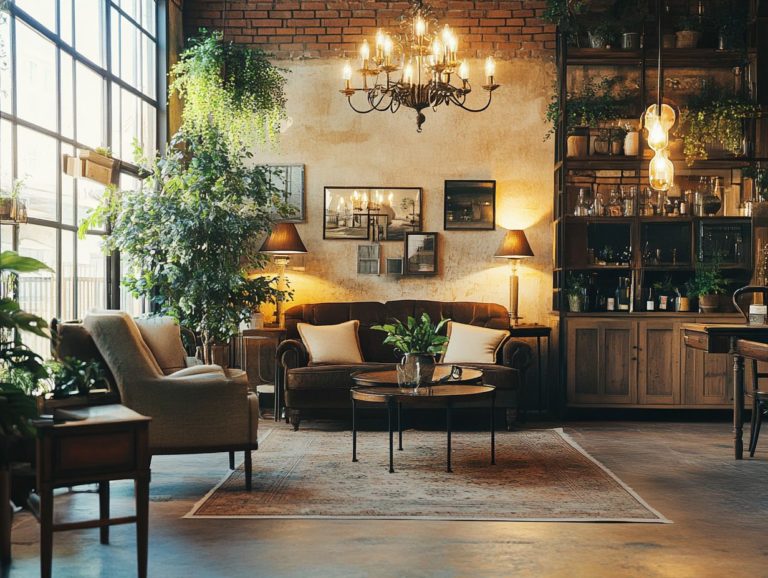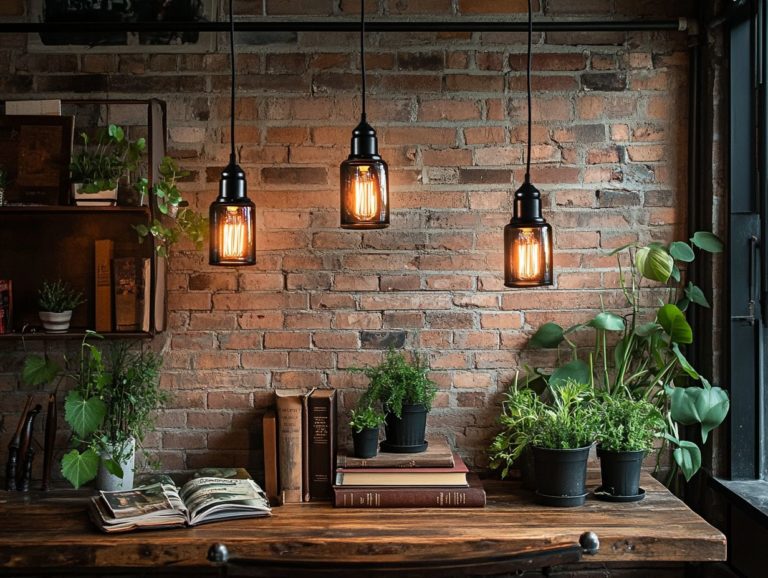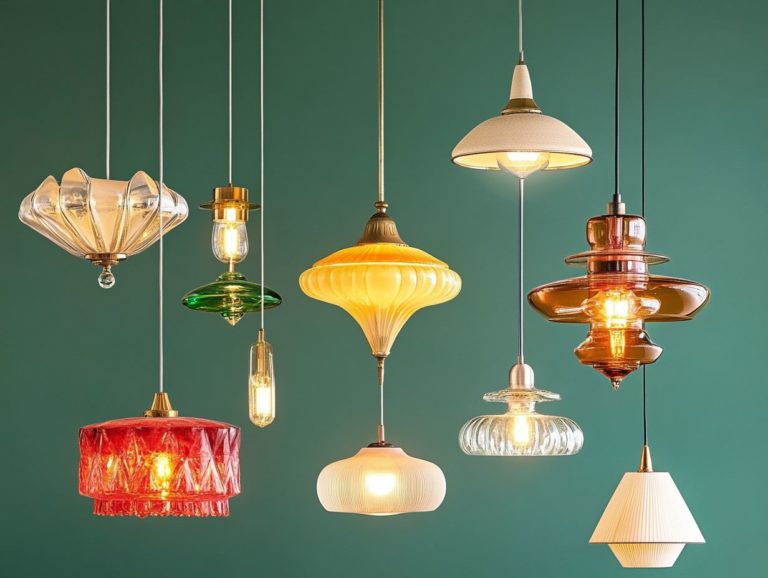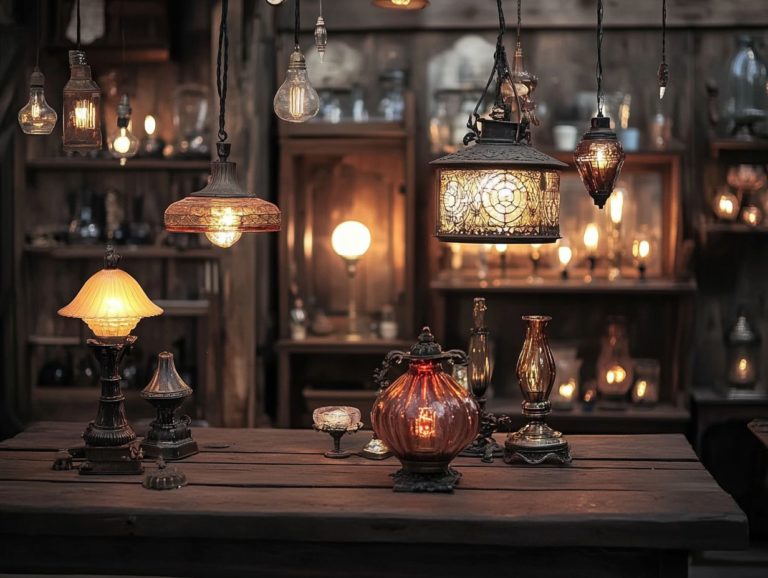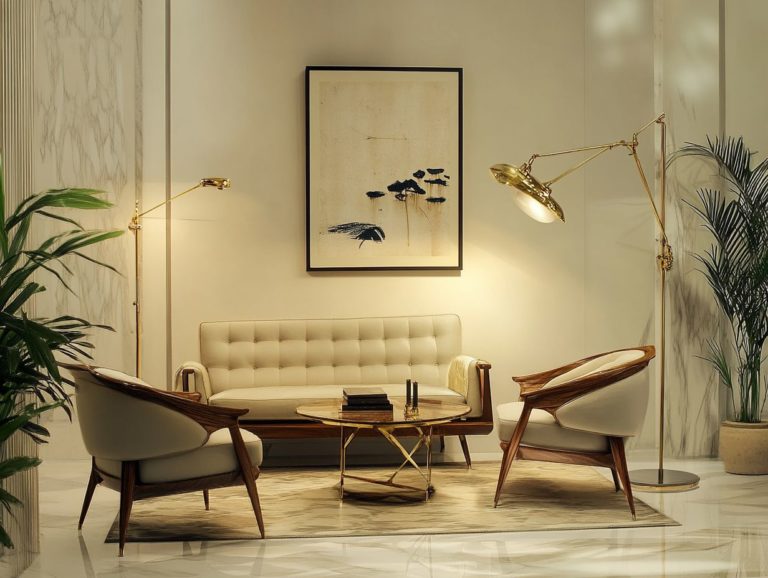Understanding Vintage Lighting Scale and Proportion
Vintage lighting infuses any space with a distinctive charm and character, but its true impact hinges on scale and proportion.
Let s explore how these elements can transform your space and why they are crucial when selecting fixtures for your home, particularly in creating visual harmony.
From grasping the nuances of room size and layout to discovering tips for achieving the perfect balance, including the dimensions of the room, you will be guided through the essential factors that can elevate your design.
Learn how to effortlessly integrate vintage pieces into modern settings, creating a cohesive and stylish aesthetic that speaks to your personal taste while respecting the aesthetic compatibility of your existing decor.
Contents
- Key Takeaways:
- Scale and Proportion in Vintage Lighting
- Factors Affecting Scale and Proportion
- Tips for Achieving Proper Scale and Proportion
- Incorporating Vintage Lighting into Modern Spaces
- Frequently Asked Questions
- What is vintage lighting scale and proportion?
- How can I determine the scale of a vintage light fixture?
- What is proportion in vintage lighting?
- How can I use vintage lighting scale and proportion to create a balanced design?
- Are there any guidelines for selecting vintage lighting based on scale and proportion?
- What are some examples of how vintage lighting scale and proportion can impact a room?
Key Takeaways:
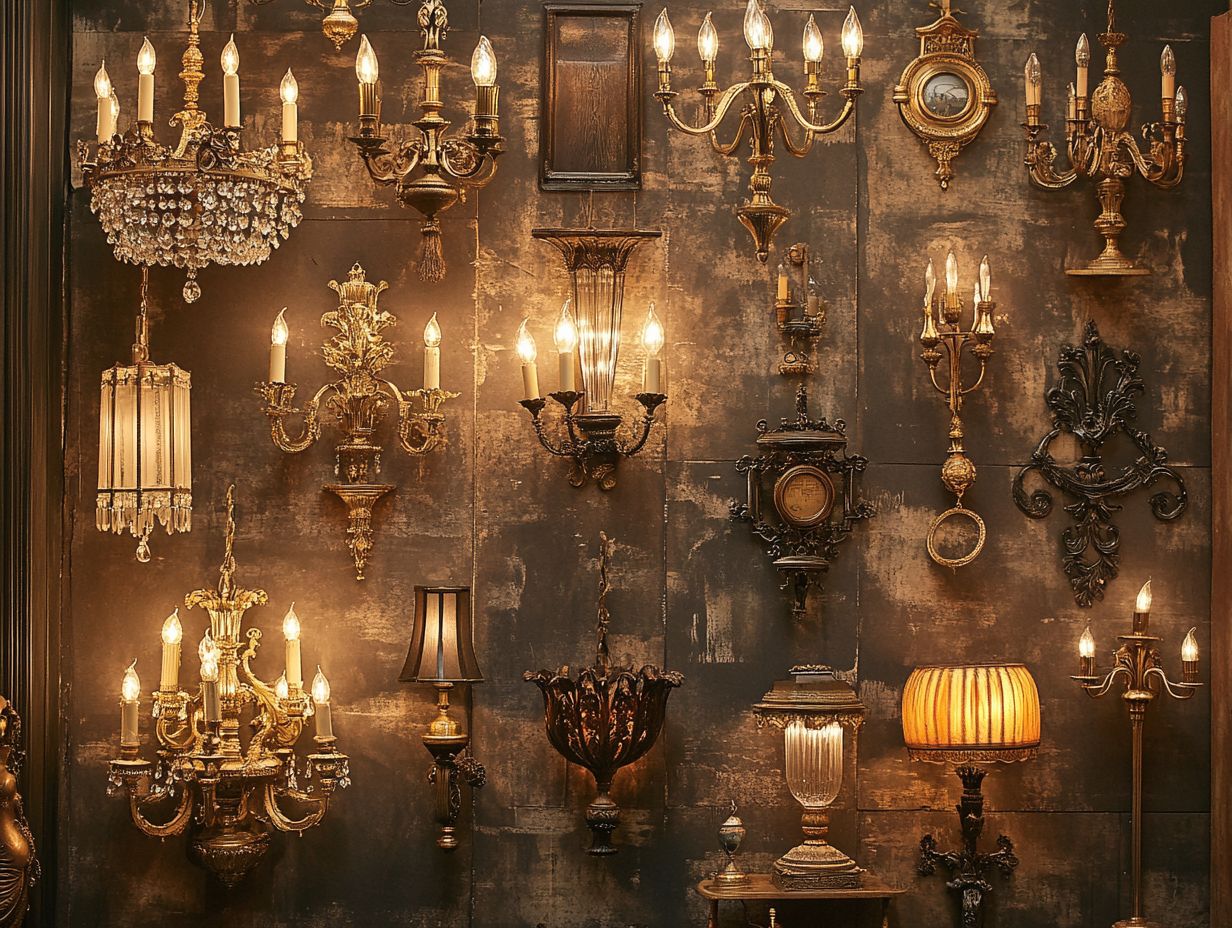
- Understanding scale and proportion is crucial for a balanced vintage lighting design.
- Room size, fixture size, and placement affect scale and proportion for a balanced interior.
- Incorporate vintage lighting into modern spaces by layering and matching styles.
What is Vintage Lighting?
Vintage lighting encompasses light fixtures and lamps that reflect historical aesthetics, often inspired by design movements like Victorian and Art Nouveau, along with more modern interpretations. These fixtures do more than just illuminate your space; they act as captivating focal points, infusing character and warmth into your interiors.
With their unique designs and exceptional craftsmanship of lighting, vintage lights often boast decorative details and layered lighting techniques that elevate the overall ambiance.
The allure of vintage lighting transcends mere functionality; it stirs a sense of nostalgia and charm, whisking you away to different eras while seamlessly complementing your modern decor. Whether you re drawn to the intricate details of a Victorian chandelier or sleek Mid-Century Modern sconces, each style brings its emotional resonance, cultivating a welcoming atmosphere.
These vintage pieces can evoke a range of feelings, from tranquility to vibrancy, shaping how you and your guests experience a space. The dance of shadows and light created by these fixtures can dramatically alter the aesthetics of a room, forging a harmonious environment that celebrates both history and contemporary elegance.
Scale and Proportion in Vintage Lighting
Understanding scale and proportion in vintage lighting is crucial for creating a comfortable home. You can create a harmonious alignment between the room’s dimensions and the design elements, furniture choices, and lighting fixtures.
By thoughtfully considering the vertical scale of chandeliers and sconces in relation to ceiling height and room size, you can achieve a cohesive space that exudes both warmth and sophistication, while maintaining appropriate lighting coverage.
Defining Scale and Proportion
Scale and proportion in interior design are all about understanding the relationship between the size of objects like those exquisite vintage lighting fixtures and their surroundings. This concept highlights the significance of visual weight and harmony, which are essential for crafting a balanced interior composition.
When you achieve the right scale, decorative accessories and lighting elements work together beautifully, enhancing both functionality and aesthetic appeal, contributing to the overall visual impact.
Take vintage lighting, for example. A large chandelier can bring an air of grandeur to a spacious dining room, while more petite pendant lights might be just right for intimate nooks. Proportion is key in this selection process; the height and width of these fixtures need to align seamlessly with your furniture dimensions and the overall layout of the room.
By selecting a lighting style that resonates with the existing architectural details like introducing a mid-century modern lamp into a retro-styled living space you create a sense of visual harmony. This thoughtful interplay of scale and proportion not only elevates your room’s design but also ensures that each lighting element fulfills its purpose without overwhelming the space.
Start transforming your home today with these vintage lighting tips!
Importance in Vintage Lighting Design
Scale and proportion are very important in vintage lighting design. They help create a pleasing look in your interiors.
Selecting lighting fixtures that match your room’s size makes a big difference. It enhances both the beauty and usability of your space.
For example, an oversized chandelier can overwhelm a small dining room. In contrast, a tiny pendant in a large kitchen might just disappear.
To achieve the right balance, consider the height and width of your fixtures. A well-placed vintage floor lamp creates a warm glow, while well-placed sconces can beautifully highlight artwork.
Understanding scale enriches your room s design and boosts its overall atmosphere.
Factors Affecting Scale and Proportion
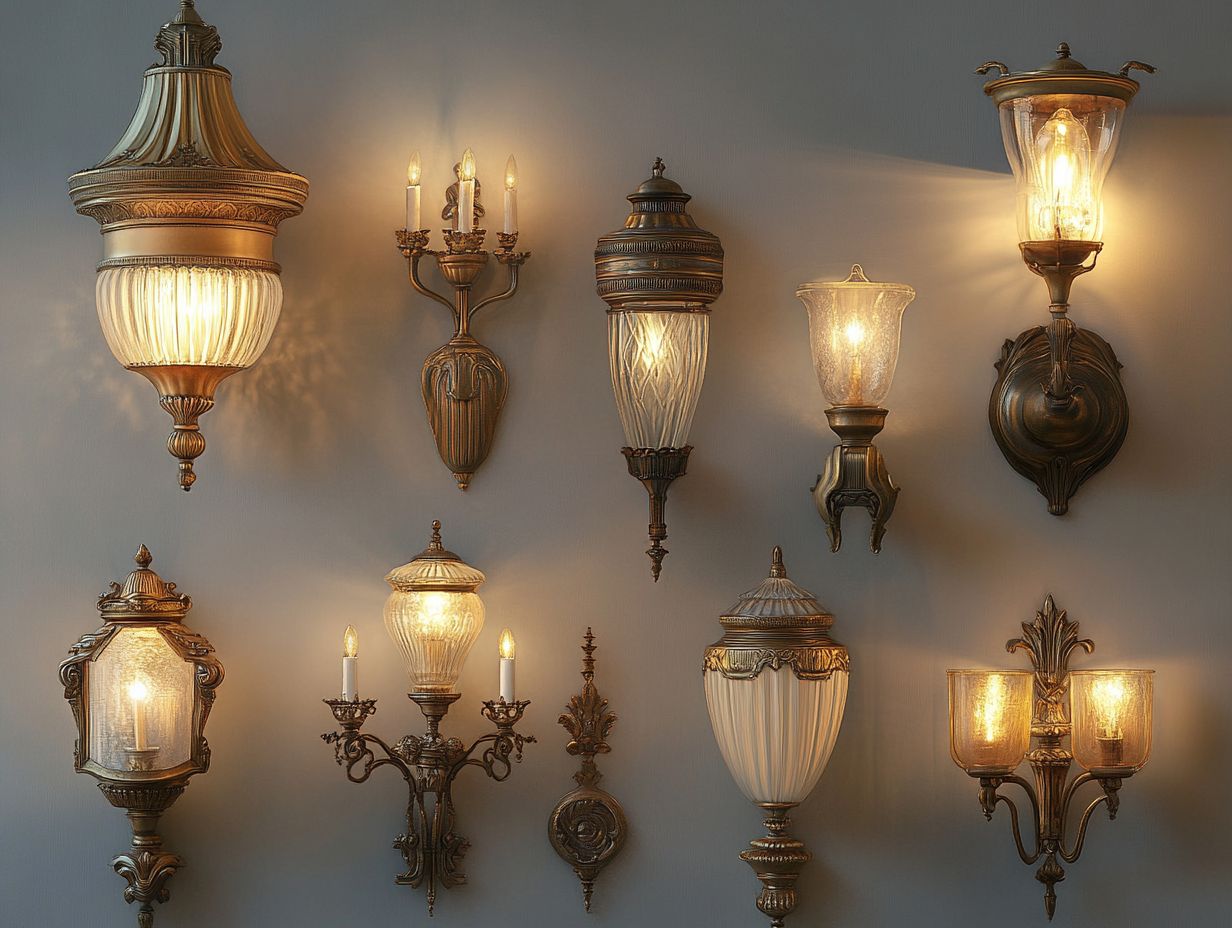
Several factors influence scale and proportion in interior design, especially with vintage lighting. Important elements include the size and layout of the room and the dimensions of the lighting fixtures.
These factors help create a harmonious space that balances functionality and beauty.
Room Size and Layout
The size and layout of a room are key in choosing the right scale for vintage lighting fixtures. They affect how visual weight is balanced in your space.
A properly sized chandelier can elevate a spacious dining area. Conversely, smaller vintage lamps work well in intimate settings.
When assessing your room, think about the height of your ceilings and furniture arrangement. A high ceiling allows for larger fixtures that draw the eye upward.
In a cozy nook, choose pendant lights that provide warmth without overwhelming the space.
By understanding how light interacts with different surfaces, you can select vintage pieces that fit and enhance your room s beauty.
Lighting Fixture Size and Shape
The size and shape of lighting fixtures are vital for maintaining scale and proportion in vintage designs. Oversized chandeliers can serve as striking focal points, while delicate sconces provide subtle enhancements.
When choosing fixtures, consider how their dimensions fit within the room’s style. A grand antique brass chandelier can add elegance to a high-ceiling dining room.
In a cozy nook, wall-mounted fixtures can offer soft light that creates intimacy. Vintage pendant lights can elevate the look of an open-concept kitchen.
These thoughtful choices shape the ambiance, influencing how everyone interacts with the space.
Placement and Balance
The placement of vintage lighting fixtures is essential for achieving balance in your design. It significantly impacts how light interacts within your space, shaping the overall atmosphere.
By thoughtfully considering where to position chandeliers, sconces, or vintage lamps, you ensure that the ambient lighting needs are met while elevating the room’s aesthetic appeal.
Effective fixture placement goes beyond just lighting; it s about crafting a visual flow. For example, mounting a chandelier at the perfect height can draw the eyes upward, engaging the entirety of the space. Sconces can be symmetrically positioned as visual anchors on walls, while table lamps should be placed intentionally to minimize shadows and enhance task areas.
Incorporate dimmers to easily adjust the lighting, further balancing the visual weight throughout the room. By harmonizing both the fixtures and their light output, you foster a warm, inviting atmosphere that is critical to your overall design.
Tips for Achieving Proper Scale and Proportion
Achieving the right scale and proportion in vintage lighting calls for a discerning approach. Explore how your lighting fixtures interact with your furniture selections and the overall dimensions of the room.
By thoughtfully addressing these elements, you’ll create a stunningly balanced interior that captures your unique style and embodies the essence of timeless elegance while showcasing your passion for collecting antiques.
Choosing the Right Size and Style
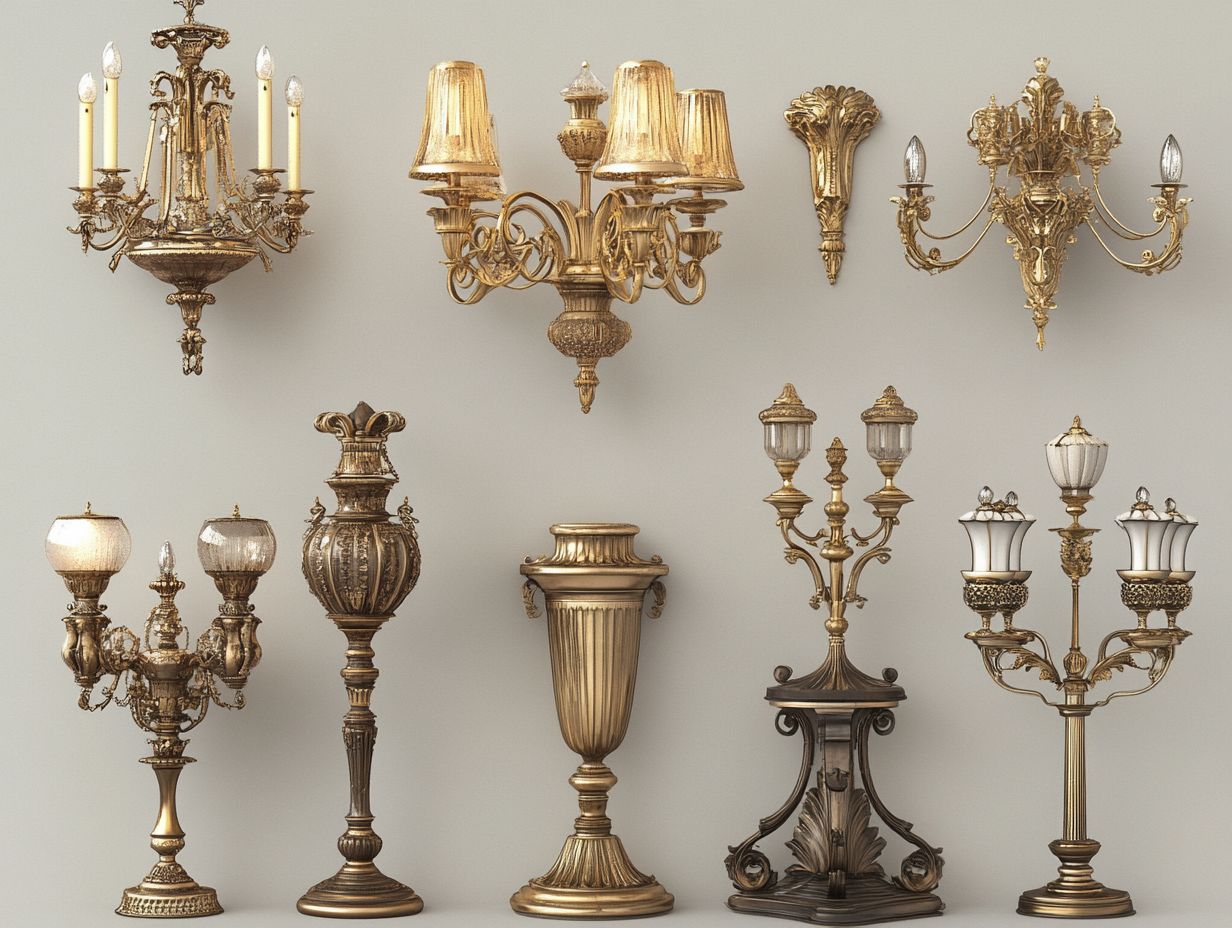
Choosing the right size and style of vintage lighting is crucial for achieving a harmonious balance in your interior design. The fixtures should complement your room’s dimensions and contribute to its overall aesthetic.
Whether you re selecting antique chandeliers that evoke a sense of history or opting for modern adaptations, understanding proportional balance is essential.
If you have larger spaces, like an open-concept living room, oversized pendant lights or grand chandeliers can serve as stunning statement pieces that draw the eye upward. Conversely, more intimate areas such as bedrooms or home offices may benefit from narrower sconces or vintage-inspired table lamps that provide warmth without overwhelming the space.
Styles like Art Deco fixtures, with their geometric elegance, can elevate modern decor, while industrial-style pendant lights add a rustic charm, perfectly suiting loft-style apartments. Aligning the vintage lighting style with the room s character not only enhances functionality but also seamlessly elevates the overall aesthetic.
Layering Lighting for Balance
Layering lighting is an essential technique for achieving balance in vintage lighting design. A harmonious mix of ambient, task, and accent lighting creates a cohesive space tailored to both functional and aesthetic needs.
Start by establishing ambient lighting with a vintage chandelier, which will illuminate the entire room and set an inviting foundation. Next, integrate task lighting consider a stylish desk lamp or a vintage wall sconce to ensure specific areas are well-lit for reading or working.
Don t forget about accent lighting; using decorative table lamps or track lighting to highlight artwork adds visual interest and a touch of personality. By blending these elements seamlessly, you can cultivate a warm, inviting atmosphere that is both functional and aesthetically pleasing, allowing each layer to support the others beautifully.
Experiment with vintage lighting in your own space to create a unique environment that reflects your style!
Considering the Room’s Function
When selecting vintage lighting, think about the room’s purpose. This will guide your choices for fixture types, styles, and placements tailored to specific lighting needs.
For a cozy reading nook, vintage lamps work wonderfully. In contrast, a gallery benefits from thoughtfully positioned chandeliers.
In the dining area, a vintage pendant light creates an inviting atmosphere. In a home office, a vintage desk lamp boosts productivity with focused lighting and style.
A vintage floor lamp in the living room can light up reading areas while enhancing decor. By balancing functionality and aesthetics, you can enrich any space with vintage lighting.
Incorporating Vintage Lighting into Modern Spaces
Bringing vintage lighting into modern spaces creates a stunning contrast that highlights unique designs. Blending antique fixtures with contemporary decor showcases the craftsmanship and historical value of vintage pieces.
This integration adds character and creates a warm, inviting atmosphere.
Mixing and Matching Styles
Mixing styles is a fantastic way to incorporate vintage lighting in modern interiors. Pairing a vintage chandelier with sleek furnishings creates visual interest.
This not only highlights unique pieces but injects personality into spaces that might feel sterile. A mid-century modern living room can thrive with an ornate vintage pendant light, becoming a focal point that sparks conversation.
However, blending styles needs careful thought. Use a unifying color palette or cohesive materials to tie vintage and modern elements together.
This fusion creates a dynamic atmosphere that reflects charm and contemporary flair.
Creating a Cohesive Look

To create a cohesive look with vintage lighting, focus on design elements like color, texture, and theme. Ensure vintage fixtures harmonize with your decor for a unified, elegant interior.
Start by assessing the room’s color scheme. Vintage lighting can either complement or contrast existing hues.
Warm gold or bronze fixtures enhance neutral palettes, while cobalt or emerald glass lighting brings vibrancy. Pay attention to surrounding textures, like soft fabrics and wooden accents, for added depth.
Ultimately, each element should interact, creating an inviting and stylish atmosphere.
Frequently Asked Questions
What is vintage lighting scale and proportion?
Vintage lighting scale and proportion refer to the size of light fixtures and how they fit within a room. Understanding these concepts helps ensure a visually pleasing design.
How can I determine the scale of a vintage light fixture?
To determine the scale of a vintage light fixture, look at its height, width, and depth. Consider the room’s size and other elements to find the right fit.
What is proportion in vintage lighting?
Proportion in vintage lighting is about how big the fixture is compared to the space around it. Choosing the right proportion ensures the fixture enhances the room.
How can I use vintage lighting scale and proportion to create a balanced design?
Understanding scale and proportion helps you choose fixtures that fit perfectly. This choice will result in a balanced and pleasing design.
Are there any guidelines for selecting vintage lighting based on scale and proportion?
While there are no strict rules, it’s often best to choose fixtures that are one-third to one-half the size of the area they will light. Personal preference and overall design should also guide your choice.
What are some examples of how vintage lighting scale and proportion can impact a room?
Poorly scaled vintage lighting can make a room feel crowded. On the other hand, well-proportioned lighting enhances the aesthetic and creates a beautiful space.

